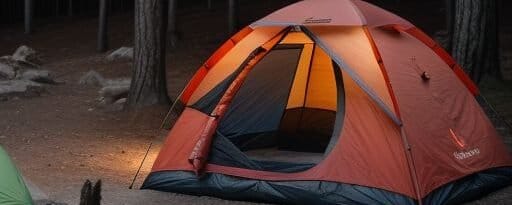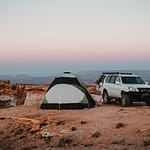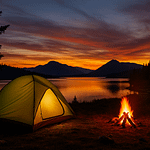Camping on Public Lands: Read This First!
The Complete Guide to Free Camping on Public Lands: Everything You Need to Know
Last updated: June 2025
Picture this: You’re sitting around a crackling campfire under a blanket of stars, with nothing but wilderness stretching out in every direction. The best part? You’re camping completely free on public land. If this sounds like your kind of adventure, you’ve come to the right place.
Free camping on public lands isn’t just a budget-friendly way to explore the outdoors—it’s a gateway to some of the most incredible, untouched landscapes in America. But before you pack up your gear and head out, there’s a lot you need to know to camp safely, legally, and responsibly.
Table of Contents
- What Exactly Is Public Land?
- Why Choose Free Camping on Public Lands?
- Understanding Dispersed Camping vs. Developed Campgrounds
- How to Find the Best Free Camping Spots
- BLM Land: The Crown Jewel of Free Camping
- National Forest Camping: A Different Experience
- Can You Camp Anywhere in National Parks?
- Essential Gear for Public Land Camping
- Campfire Safety and Regulations
- Common Challenges and How to Handle Them
- Making the Most of Your Public Land Camping Experience
- Planning Your First Public Land Camping Trip
- Frequently Asked Questions
What Exactly Is Public Land?
Let’s start with the basics. Public land refers to areas owned and managed by federal or state governments that are open for public use. Think of it as your backyard—except it’s millions of acres of forests, deserts, mountains, and prairies that belong to all of us.
The main players in federal public land management are:
- Bureau of Land Management (BLM) – Manages about 245 million acres
- U.S. Forest Service (USFS) – Oversees 193 million acres of national forests
- National Park Service – Manages national parks and monuments
- U.S. Fish and Wildlife Service – Oversees wildlife refuges
Each agency has different rules, so what works on BLM land might not fly in a national park.
Why Choose Free Camping on Public Lands?
The Money Factor
Let’s be honest—camping fees can add up fast. Private campgrounds often charge $30-60 per night, while most public land camping is completely free. That’s hundreds of dollars you can save on a long road trip.
Escape the Crowds
Tired of camping elbow-to-elbow with other families? Public land camping offers solitude that’s hard to find elsewhere. You might go days without seeing another soul.
Flexibility and Freedom
No reservations needed. No check-in times. No “quiet hours” enforced by campground hosts. You set your own schedule and choose your own perfect spot.
Wildlife and Nature
Public lands are home to incredible wildlife. Where else can you wake up to elk grazing outside your tent or watch eagles soar overhead while you sip your morning coffee?
Understanding Dispersed Camping vs. Developed Campgrounds
Developed Campgrounds
These are your traditional camping spots with:
- Designated campsites
- Picnic tables and fire rings
- Restrooms (sometimes with showers)
- Potable water
- Usually require fees ($10-25/night)
Perfect for: Families, first-time public land campers, anyone who wants amenities
Dispersed Camping (Boondocking)
This is where the real adventure begins. Dispersed camping means:
- Camping outside designated campgrounds
- No amenities (bring your own water, food, and waste disposal)
- Usually completely free
- More remote and secluded
- Requires self-sufficiency
Perfect for: Experienced campers, adventure seekers, anyone wanting to truly disconnect
How to Find the Best Free Camping Spots
Start with Official Resources
BLM Website and Apps:
- Visit blm.gov for interactive maps
- Download the BLM Maps app for offline access
- Check for seasonal closures and fire restrictions
Forest Service Resources:
- Use the National Forest Locator at fs.usda.gov
- Download the Motor Vehicle Use Maps (MVUMs) for your area
- Contact local ranger stations for current conditions
Popular Apps and Websites
While I can’t recommend specific third-party apps, many campers use crowd-sourced platforms to share camping spots. Just remember to verify information with official sources.
Local Knowledge
Stop by BLM field offices or ranger stations. The staff are incredibly knowledgeable and can point you toward hidden gems that aren’t well-known online.
BLM Land: The Crown Jewel of Free Camping
BLM land is often called the “crown jewel” of free camping, and for good reason. The Bureau of Land Management is generally the most permissive when it comes to dispersed camping.
BLM Camping Rules (The Basics)
- 14-day limit: You can camp in one spot for up to 14 days
- Move 25 miles: After 14 days, you must move at least 25 miles away
- No permanent structures: Don’t build anything permanent
- Stay on designated roads: Don’t drive off-road to reach camping spots
Is It Safe to Camp on BLM Land?
Safety is always a concern when camping in remote areas. Here’s the reality:
The Good News:
- Most BLM land is very safe
- Crime rates are generally low in remote areas
- Other campers are usually friendly and helpful
Safety Considerations:
- Cell service is often spotty or nonexistent
- Emergency services may be far away
- Weather can change quickly
- Wildlife encounters are possible
Stay Safe by:
- Telling someone your plans and expected return
- Bringing emergency communication devices
- Carrying extra water, food, and supplies
- Knowing basic first aid
- Checking weather forecasts
What About Leaving Your RV Unattended?
This is a common concern for RV campers. While theft is rare on BLM land, it’s not unheard of. Here are some tips:
- Choose camping spots that aren’t too visible from main roads
- Remove valuable items when leaving
- Consider security systems or GPS trackers
- Connect with other campers for mutual watching
- Trust your instincts about locations
National Forest Camping: A Different Experience
National forests offer a different flavor of free camping. The forests are often more lush and green than BLM desert lands, but the rules can be more restrictive.
Forest Service Dispersed Camping Rules
- 14-day limit (same as BLM)
- Must camp 150 feet from water sources
- No camping in meadows or sensitive areas
- Stricter fire restrictions
Finding Forest Service Camping
Use the Motor Vehicle Use Maps (MVUMs) to find legal camping areas. These maps show where you can drive and camp legally.
Can You Camp Anywhere in National Parks?
Here’s where things get tricky. Most national parks do NOT allow dispersed camping. You’ll need to stay in designated campgrounds, which usually require reservations and fees.
Exceptions exist in some parks, particularly in designated wilderness areas, but you’ll need special permits and must follow strict backcountry camping rules.
Essential Gear for Public Land Camping
The Basics
Shelter:
- Tent suitable for expected weather
- Sleeping bag rated for nighttime temperatures
- Sleeping pad for comfort and insulation
Water:
- Bring more than you think you need (1 gallon per person per day)
- Water filtration system for longer stays
- Collapsible water containers
Food and Cooking:
- Portable camping stove (campfires may be restricted)
- Fuel for your stove
- Non-perishable food items
- Cooler with ice for shorter trips
Comfort and Safety Items
- First aid kit
- Flashlights and extra batteries
- Portable phone charger/power bank
- Weather radio
- Emergency whistle
- Maps and compass (don’t rely only on GPS)
Leave No Trace Essentials
- Trash bags (pack out everything)
- Toilet paper and trowel
- Biodegradable soap
- Wet wipes
Campfire Safety and Regulations
Campfires are often restricted or prohibited on public lands, especially during fire season (typically May through October in many areas).
Before You Build a Fire
- Check current fire restrictions
- Use only existing fire rings when available
- Clear the area of flammable materials
- Have water and a shovel nearby
- Never leave a fire unattended
Fire Restrictions to Know
- No fires allowed: Complete fire ban
- Campfires only: Fires allowed only in designated fire rings
- Dispersed camping fires: Fires allowed in cleared areas with safety precautions
Common Challenges and How to Handle Them
Overcrowding
Popular spots can get crowded, especially on weekends and holidays. Solutions:
- Camp during weekdays
- Have backup locations planned
- Explore less-known areas
- Camp during shoulder seasons
No Cell Service
This is often a feature, not a bug, but it requires preparation:
- Download offline maps
- Tell someone your plans
- Bring emergency communication devices
- Know basic navigation skills
Weather Changes
Mountain weather can change rapidly:
- Check forecasts before leaving
- Be prepared for temperature swings
- Know signs of dangerous weather
- Have an exit strategy
Making the Most of Your Public Land Camping Experience
Respect the Land and Others
- Follow Leave No Trace principles
- Keep noise levels down
- Respect wildlife and their habitats
- Be friendly to other campers
- Report any problems to authorities
Explore Responsibly
- Stay on designated roads and trails
- Don’t drive off-road to reach camping spots
- Respect private property boundaries
- Follow area-specific rules and regulations
Connect with Nature
- Put away electronic devices
- Practice outdoor skills
- Observe wildlife from a distance
- Enjoy the silence and solitude
- Take time to appreciate the landscape
Planning Your First Public Land Camping Trip
Start Small
If you’re new to public land camping, start with:
- A developed campground for your first trip
- Areas close to home
- Short trips (1-2 nights)
- Times when weather is mild
Research Thoroughly
- Check agency websites for current conditions
- Read recent reviews and reports
- Contact local offices with questions
- Have backup plans ready
Pack Smart
- Bring more water than you think you need
- Pack for temperature extremes
- Include emergency supplies
- Don’t forget entertainment for bad weather
Frequently Asked Questions
Is dispersed camping really free?
Yes, dispersed camping on most BLM and Forest Service land is free. Some areas may require permits or have fees for special use.
Can I bring my RV or travel trailer?
Most areas allow RVs, but check road conditions and size restrictions. Some remote areas may not be suitable for large RVs.
What if I encounter wildlife?
Store food properly, make noise while hiking, and know what to do if you encounter specific animals in your area.
Can I camp during hunting season?
Yes, but wear bright colors and be extra cautious. Check local hunting regulations and seasons.
What about bathroom facilities?
Dispersed camping areas typically don’t have restrooms. You’ll need to dig catholes at least 200 feet from water sources.
How do I find water for drinking and cooking?
Bring your own water for dispersed camping. If you must use natural water sources, always filter or purify the water first.
What’s the best time of year for public land camping?
It depends on the location and elevation. Generally, spring and fall offer the best weather, but check specific areas for seasonal accessibility.
Do I need any special permits?
Most dispersed camping doesn’t require permits, but some areas do. Check with the managing agency before your trip.
The Bottom Line
Free camping on public lands offers some of the most rewarding outdoor experiences you can have. It’s a chance to disconnect from the digital world, reconnect with nature, and explore some of America’s most beautiful landscapes—all without breaking the bank.
Yes, it requires more planning and preparation than staying at a KOA, but the rewards are worth it. There’s something magical about watching the sunrise over untouched wilderness from your own private campsite, knowing you’re experiencing something that fewer and fewer people get to enjoy.
Start small, research thoroughly, and always prioritize safety and Leave No Trace principles. With a little preparation and the right mindset, you’ll discover why so many people are passionate about public land camping.
The wilderness is calling—are you ready to answer?
Ready to start planning your public land camping adventure? Remember to check current conditions, fire restrictions, and regulations before you go. Happy camping!











